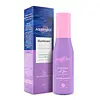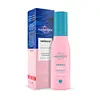What's inside
What's inside
 Key Ingredients
Key Ingredients

 Benefits
Benefits

 Concerns
Concerns

 Ingredients Side-by-side
Ingredients Side-by-side

Water
Skin ConditioningCaprylic/Capric Triglyceride
MaskingSodium Acrylates Copolymer
Lecithin
EmollientDimethicone
EmollientGlyceryl Stearate
EmollientPolyglycerin-3
HumectantPhenoxyethanol
PreservativeEthylhexylglycerin
Skin ConditioningCetearyl Olivate
Sorbitan Olivate
EmulsifyingShea Butter Glycerides
EmulsifyingFragaria Vesca Fruit Extract
AstringentSodium Benzoate
MaskingImidazolidinyl Urea
PreservativeAcrylates/C10-30 Alkyl Acrylate Crosspolymer
Emulsion StabilisingEthoxydiglycol
HumectantTocopherol
AntioxidantSodium Gluconate
Skin ConditioningGlycerin
HumectantGlyceryl Glucoside
HumectantPanthenol
Skin ConditioningAlpha-Arbutin
AntioxidantHyaluronic Acid
HumectantSoyethyl Morpholinium Ethosulfate
Water, Caprylic/Capric Triglyceride, Sodium Acrylates Copolymer, Lecithin, Dimethicone, Glyceryl Stearate, Polyglycerin-3, Phenoxyethanol, Ethylhexylglycerin, Cetearyl Olivate, Sorbitan Olivate, Shea Butter Glycerides, Fragaria Vesca Fruit Extract, Sodium Benzoate, Imidazolidinyl Urea, Acrylates/C10-30 Alkyl Acrylate Crosspolymer, Ethoxydiglycol, Tocopherol, Sodium Gluconate, Glycerin, Glyceryl Glucoside, Panthenol, Alpha-Arbutin, Hyaluronic Acid, Soyethyl Morpholinium Ethosulfate
Water
Skin ConditioningGlycerin
HumectantCaprylic/Capric Triglyceride
MaskingIsopropyl Myristate
EmollientNiacinamide
SmoothingGlyceryl Stearate Citrate
EmollientPentaerythrityl Distearate
EmulsifyingPhenoxyethanol
PreservativeAmmonium Polyacryloyldimethyl Taurate
Emulsion StabilisingBehenyl Alcohol
EmollientCitrullus Lanatus Fruit Extract
Skin ConditioningHyaluronic Acid/Polyglutamic Acid Crosspolymer
AntioxidantEthylhexylglycerin
Skin ConditioningTitanium Dioxide
Cosmetic ColorantIsopropyl Palmitate
EmollientGlyceryl Glucoside
HumectantTrisodium Ethylenediamine Disuccinate
Aluminum Hydroxide
EmollientLauric Acid
CleansingCitric Acid
BufferingPentylene Glycol
Skin ConditioningPotassium Sorbate
PreservativeSodium Benzoate
MaskingParfum
MaskingWater, Glycerin, Caprylic/Capric Triglyceride, Isopropyl Myristate, Niacinamide, Glyceryl Stearate Citrate, Pentaerythrityl Distearate, Phenoxyethanol, Ammonium Polyacryloyldimethyl Taurate, Behenyl Alcohol, Citrullus Lanatus Fruit Extract, Hyaluronic Acid/Polyglutamic Acid Crosspolymer, Ethylhexylglycerin, Titanium Dioxide, Isopropyl Palmitate, Glyceryl Glucoside, Trisodium Ethylenediamine Disuccinate, Aluminum Hydroxide, Lauric Acid, Citric Acid, Pentylene Glycol, Potassium Sorbate, Sodium Benzoate, Parfum
Ingredients Explained
These ingredients are found in both products.
Ingredients higher up in an ingredient list are typically present in a larger amount.
This ingredient is an emollient, solvent, and texture enhancer. It is considered a skin-softener by helping the skin prevent moisture loss.
It helps thicken a product's formula and makes it easier to spread by dissolving clumping compounds.
Caprylic Triglyceride is made by combining glycerin with coconut oil, forming a clear liquid.
While there is an assumption Caprylic Triglyceride can clog pores due to it being derived from coconut oil, there is no research supporting this.
Learn more about Caprylic/Capric TriglycerideEthylhexylglycerin (we can't pronounce this either) is commonly used as a preservative and skin softener. It is derived from glyceryl.
You might see Ethylhexylglycerin often paired with other preservatives such as phenoxyethanol. Ethylhexylglycerin has been found to increase the effectiveness of these other preservatives.
Glycerin is already naturally found in your skin. It helps moisturize and protect your skin.
A study from 2016 found glycerin to be more effective as a humectant than AHAs and hyaluronic acid.
As a humectant, it helps the skin stay hydrated by pulling moisture to your skin. The low molecular weight of glycerin allows it to pull moisture into the deeper layers of your skin.
Hydrated skin improves your skin barrier; Your skin barrier helps protect against irritants and bacteria.
Glycerin has also been found to have antimicrobial and antiviral properties. Due to these properties, glycerin is often used in wound and burn treatments.
In cosmetics, glycerin is usually derived from plants such as soybean or palm. However, it can also be sourced from animals, such as tallow or animal fat.
This ingredient is organic, colorless, odorless, and non-toxic.
Glycerin is the name for this ingredient in American English. British English uses Glycerol/Glycerine.
Learn more about GlycerinGlyceryl Glucoside is made from glycerol and glucose.
It is a humectant. Humectants help hydrate your skin by drawing moisture to it from the air.
Some foods that contain glyceryl glucoside include sake, miso, and wines.
Learn more about Glyceryl GlucosidePhenoxyethanol is a preservative that has germicide, antimicrobial, and aromatic properties. Studies show that phenoxyethanol can prevent microbial growth. By itself, it has a scent that is similar to that of a rose.
It's often used in formulations along with Caprylyl Glycol to preserve the shelf life of products.
Sodium Benzoate is a preservative. It's used in both cosmetic and food products to inhibit the growth of mold and bacteria. It is typically produced synthetically.
Both the US FDA and EU Health Committee have approved the use of sodium benzoate. In the US, levels of 0.1% (of the total product) are allowed.
Sodium benzoate works as a preservative by inhibiting the growth of bacteria inside of cells. It prevents the cell from fermenting a type of sugar using an enzyme called phosphofructokinase.
It is the salt of benzoic acid. Foods containing sodium benzoate include soda, salad dressings, condiments, fruit juices, wines, and snack foods.
Studies for using ascorbic acid and sodium benzoate in cosmetics are lacking, especially in skincare routines with multiple steps.
We always recommend speaking with a professional, such as a dermatologist, if you have any concerns.
Learn more about Sodium BenzoateWater. It's the most common cosmetic ingredient of all. You'll usually see it at the top of ingredient lists, meaning that it makes up the largest part of the product.
So why is it so popular? Water most often acts as a solvent - this means that it helps dissolve other ingredients into the formulation.
You'll also recognize water as that liquid we all need to stay alive. If you see this, drink a glass of water. Stay hydrated!
Learn more about Water